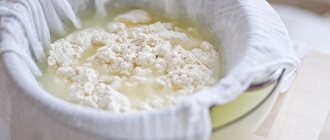Why does bread spoil quickly?
Bread is included in the list of perishable products due to its composition. You've probably noticed that a loaf bought in the morning loses its freshness, taste and aroma by the evening. If the bread has been untouched for several days, mold may appear on its surface.
Modern bread is very different from the products that our grandparents ate. Then it simply became stale and dried out, and now even after 2-3 days of storage it becomes moldy. This phenomenon can occur due to various reasons:
- a large number of impurities and emulsifiers have been added to the composition;
- stale raw materials were used;
- production technology is disrupted;
- storage and transportation standards are not met;
- non-compliance with safety regulations at work.
To always buy fresh rolls and loaves, pay attention to several characteristics:
- Crust condition. It should be smooth without burnt areas.
- Crumb density. It shouldn't crumble.
- Aroma. Its absence or change indicates that the product has been sitting for a long time.
It is best to buy bread from a trusted seller, who will tell you how long the loaves, if they are unpackaged, have been lying on the counter.
What material to use for storing bread
The product will stay fresh longer if you choose the right storage container. Natural fabric or paper copes well with this function. Plastic, polyethylene or foil also preserve the freshness of bread well. However, when using them, take care of ventilation inside, since condensation appears on the inner surface of such materials.
At what temperature should you store bread?

The optimal temperature for storing bread is 20–25 degrees. In this temperature range, the product retains its best consumer characteristics. Like many other products, baked goods do not tolerate sudden temperature changes. Make sure that the room where the bread is located is well ventilated, dry and clean, and the relative air humidity does not exceed 75%.
How to store freshly baked bread
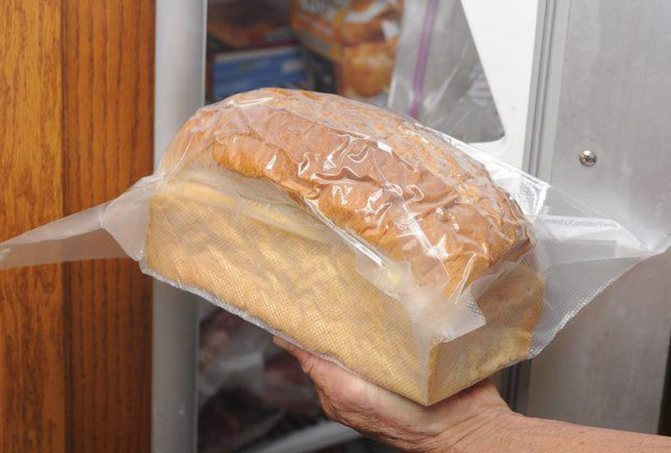
If you are pampering your family with fresh baked goods, prepared yourself, take into account the following rules:
- Try to remove the product from the mold as quickly as possible, otherwise the crust will not be crispy.
- Do not pack hot bread until it has cooled completely.
- For storage containers, use a plastic or paper bag, a towel made of natural fabric, or simply put the baked goods in a bread bin.
Where is the best place to store bread at home?
Most importantly, do not leave the finished loaf outdoors, especially in direct sunlight. To keep the product fresh for as long as possible, use various storage devices.
Foil or plastic bag
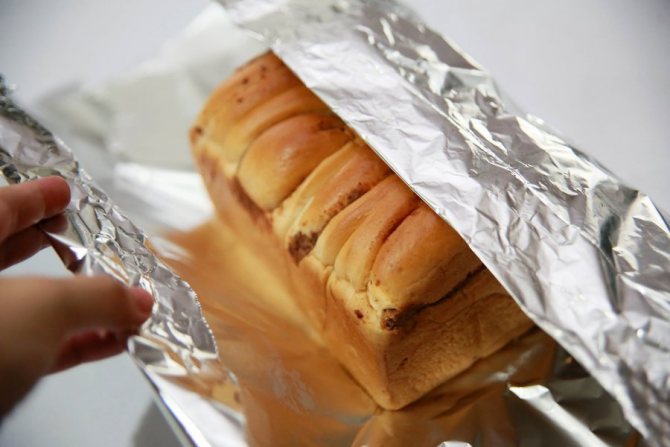
Polyethylene or foil do a good job of preserving the freshness of bread, but only with proper storage. Basic rules for storing bread in a bag or foil:
- Use only a new bag or piece of foil to avoid mold.
- Close the package tightly to prevent the bun from drying out.
- At the same time, do not allow moisture to collect inside. To do this, make several small holes in the packaging.
In the original polyethylene packaging, the bread will last for at least 3 days, provided that you close the bag tightly.
Paper, textile or clay
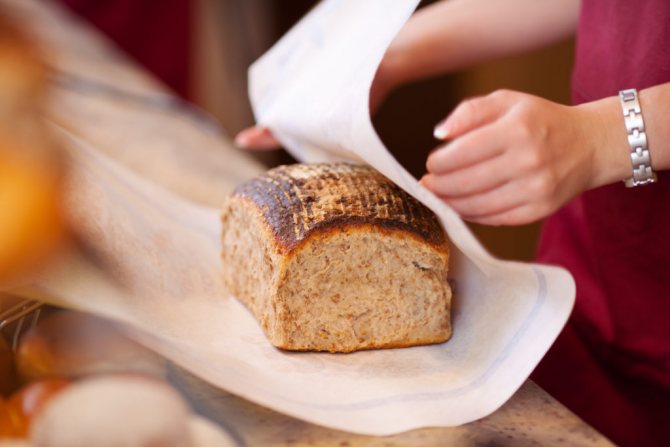
This storage method came to us from our grandmothers. In the old days, it was customary to wrap bread in a piece of natural fabric. This way it could stay fresh for at least 2 days. The method is still popular among many housewives. Use kitchen towels made from natural materials without a pattern or a special fabric bag for bakery products for storage. The bags consist of 3 layers: the outer and inner are breathable materials, the middle is perforated polyethylene. You can buy similar devices in the hardware department of the supermarket.
An excellent place for storage would be paper bags, which are often sold in stores. The material prevents the product from drying out, breathes well, and does not allow moisture to pass through. In a closed paper bag, the loaf will remain fresh for up to 3 days.

An alternative to a bread box is a simple clay pot. The material will help keep the product fresh for 5–7 days. To achieve these results, simply cover a fresh loaf with a clay pot.
Vacuum
In vacuum packaging, bread can last from 7 to 10 days. After this time, the product will remain as soft and fresh as it was before storage.
Breadbox
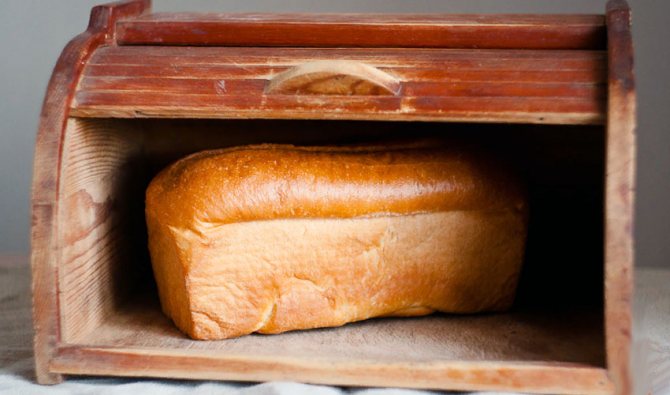
A classic option for storing bread. In addition to its main function, the bread box also acts as an element of kitchen decor. In the range of products for storing food you will find products made of metal, wood, plastic or clay. Each material has different performance characteristics.
The loaf can stay fresh for up to one week if you first wrap it in a linen towel and make sure the lid of the bread bin is always closed
How to restore freshness to bread?
You can revive bread by moistening and heating it. You just need to do this correctly, provided that it is without traces of mold:
- In the microwave. Sprinkle the loaf with water or wrap it in a wet, well-wrung out towel. Place in the microwave for 20 seconds, check for softness, and repeat the procedure if necessary. The slices can simply be placed in the microwave, placing a cup of water next to them. The evaporating moisture will saturate them and make them softer.
- In the oven. The method is similar, only the moistened bread is wrapped in food foil. Place in an oven preheated to 180 degrees for 10-15 minutes. After this, take out the loaf, let it cool a little, and then remove the foil.
- In a slow cooker. Happy owners of this technique can easily make bread soft using the steaming mode. For slices, 2 minutes is enough. Instead of a multicooker, a regular steam bath will do.
- In the package. A simple but time-consuming method. It is necessary to place the slightly stale loaf in a plastic bag, close it tightly, and place it in a warm place. In the hot summer, a lighted window sill is suitable, in winter - a radiator. The heat will cause condensation to form in the bag, which will return the bread's softness.
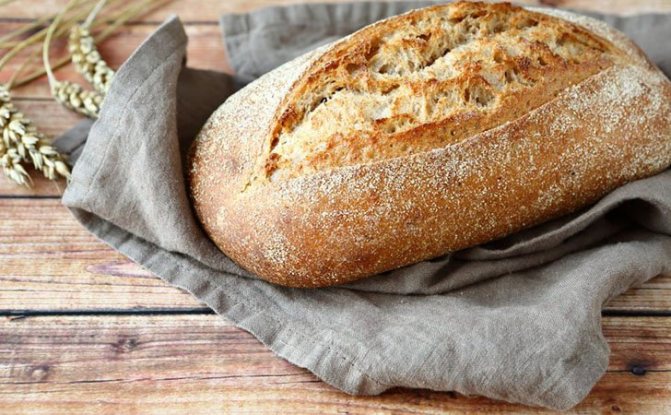
All the methods described should be used immediately before consuming the product, because they can only revive it for a few hours, then it will begin to go stale again.
Bread is an amazing product; it never gets boring. If you store it correctly, it will remain fresh for a long time and will not lose its beneficial properties.
Can bread be stored in the refrigerator?
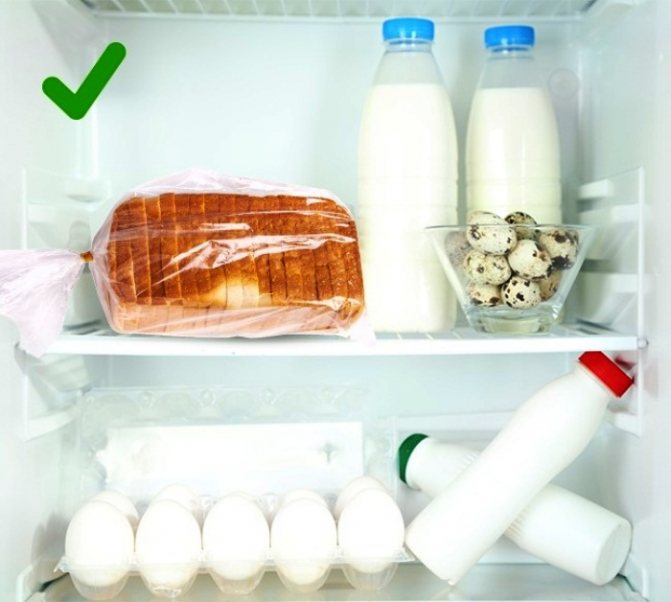
Some housewives keep bread in the refrigerator and claim that it stays fresh for 5-7 days. On the one hand, the refrigerator helps to avoid the appearance of mold, since the temperature from 0 to 2 degrees prevents its occurrence. On the other hand, such a temperature lowers the level of moisture in products, so the bread goes stale much faster.
If you decide to keep the loaf in the refrigerator, don't neglect packaging it. Wrap the loaf in paper or cloth. When using plastic bags or foil, make sure there are holes in the surface for ventilation.
Is it harmful to store bread in the refrigerator?
Of course, it’s up to you to keep the bread in the refrigerator or just in the room. However, please note that this storage option may cause problems:
- the bread will absorb the smells of other products lying on the shelf of the refrigerator next door;
- other foods will absorb the smell of yeast;
- if you place a loaf in polyethylene without holes, it will definitely become moldy;
- When a hot product is placed in the refrigerator, the compressor may become unusable due to the steam released by the bread.
How long can bread be stored in the freezer?
An interesting fact is that the rate of starch crystallization is significantly reduced at temperatures from -10 degrees. Based on this information, we can assume that the bread can last in the freezer for a long time. And indeed it is.
To keep the product for a long time at a temperature of -13 to -18 degrees:
- Place only fresh bread at room temperature into the chamber;
- be sure to pack the product in a bag or foil;
- do not refreeze the rolls;
- For convenience, mark the freezing date directly on the packaging or package the product in portions.
If these conditions are met, the bread will last in the freezer for 2 to 16 weeks.
Keep the frozen product at room temperature for several hours or use an oven, microwave or bread maker to defrost.
What kind of bread is not stored in the refrigerator?
If you are satisfied with the option of storing bread in the refrigerator, please note that it is unacceptable to keep certain types of products on the refrigerator shelf. Namely:
- hot baked goods, which will only harm the refrigerator compressor;
- already spoiled bread with mold appearing on the crust;
- bakery products without packaging.
Otherwise, for this storage option, you can choose any type and variety of products.
What determines the shelf life of bread?
There are a number of certain conditions that affect the shelf life of bread products:
- baking composition. Manufacturers often add various preservatives and thickeners to bread. They can significantly harm your health, so it is better to avoid loaves and rolls that indicate that they can be stored for more than two weeks. The shelf life of bread products can be increased by adding a little rye flour to wheat flour. This will allow the bread to go stale much slower. This process is also slowed down by added fats and sugar, which “lock” the moisture in the middle of the bun for a long time. On the contrary, the presence of barley or corn flour in bread significantly reduces its shelf life,
- Baking technology is one of the important conditions that can change the shelf life. If high-speed kneading is used, and also if the dough ferments for a long time, the bread will become stale quickly,
- storage temperature. If the bread is kept in a cold room (from -18 to -22 degrees), it will not spoil for a very long time, up to several months.
- humidity level. The most acceptable humidity level for storing baked goods is 75%. With high humidity, bread can become moldy, and if the moisture level drops, it can quickly become stale.
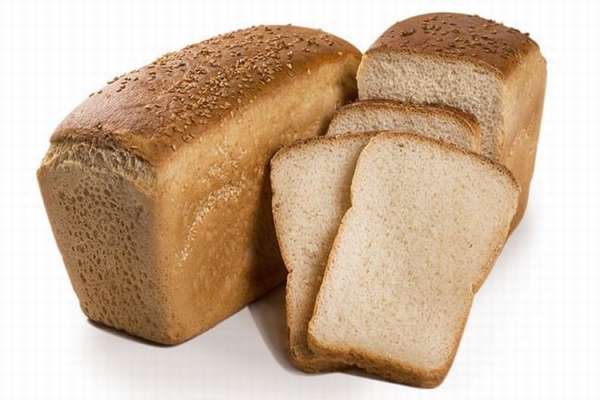
Which bread box is best to store bread in?
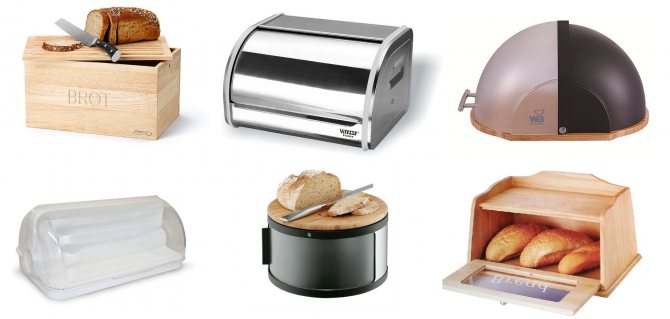
You can understand which bread box is better by analyzing the characteristics of products made from various materials.
Bread bins:
- made of wood have the highest hypoallergenic and antiseptic properties, but require the most careful care and can become damp;
- made of plastic - cheap and practical, but quickly deteriorate;
- made of clay or glass perform well, but are too fragile;
- made from metal has the best heat and aroma retention properties, are durable and easy to care for, but are slightly more expensive than analogs made from other materials.
When choosing a product, think about what characteristics come first for you, and make a choice based on your preferences. When purchasing, make sure that the lid closes tightly and that there are as few ventilation holes on the body as possible.
If you usually buy several types of bread at once, give preference to bread bins with several sections. Otherwise, keep products with different compositions by packing each in a separate bag.
How to store so that bread does not go moldy
To prevent mold from appearing on the crust for as long as possible:
- Place a handful of salt or an apple slice in the place where you store your baked goods. As soon as the apple begins to rot, replace the old slice with a new one;
- Keep the bread bin clean - wash the inside surface weekly with water and vinegar and do not allow moisture to remain inside;
- remove crumbs from the bread bin in a timely manner;
- a product prepared with vegetable rather than animal fats is less susceptible to fungus;
- Always keep the bread bin closed.
To prevent baked goods from becoming stale, cut the loaf not from the edge, but from the middle. After cutting the required number of slices, fold the halves crumbwise towards each other and pack.
Black and white together or separately?

This question applies not only to black or white bread, but to all its varieties in general. Due to differences in composition, products are influenced by the external environment at different times and under the influence of different factors. For example, one type of bread will spoil in a day, while another may last for 2-3 days. If the loaves are nearby, the bacteria from the spoiled product will transfer to the high-quality product, and it will also become unusable. To prevent this from happening, keep each variety separately, in different bags or in several sections of the bread bin.
How to recognize a delay?
When buying bread in a store, you need to inspect its appearance.
It should not be dented or cracked .
It cannot have a black or green coating. It should have its own unique aroma, and not the smell of mold.
Mold primarily appears when:
- the bread was not stored correctly;
- it is not baked;
- it contains expired baked goods.
Some cut off the moldy crust and eat the bread. This is absolutely impossible to do. Why? Diseases associated with the respiratory and blood organs may occur.
If the bread contains an expired product, then when it is compressed, a slight smell of mold is felt. If you put pressure on the bread and it does not come back , then the loaf is not baked.
And it is also not healthy. When choosing a baguette, if you knock on it, the sound should be empty . In this case, it is normal for consumption.
You will also find recommendations for storing cottage cheese after purchase on our website.
How to store different types of bread
The components that make up different types of bread have different properties. This means that one type of baked goods can stay fresh for a long time, while another cannot.
Wholegrain
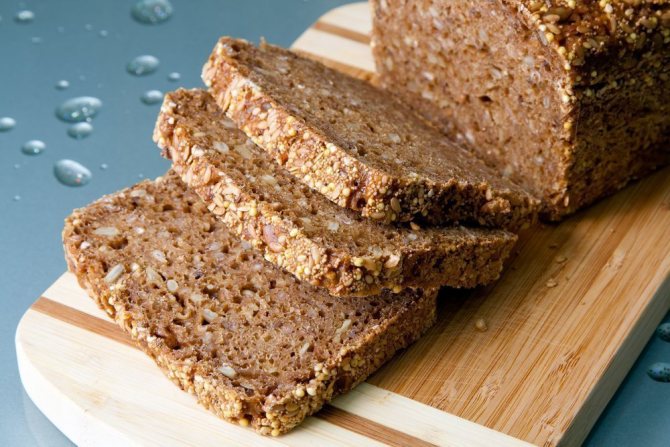
In the production of whole grain bread, sprouted wheat seeds are used, thanks to which the product is considered very healthy. When choosing such baked goods, pay attention to the ingredients on the packaging. The first component should be whole grain flour.
Also, the composition should contain a minimum of impurities and preservatives.
Real whole grain bread will stay fresh for 48 hours and 72 hours when packaged. Optimal storage conditions are a dry, ventilated room with a temperature of 20–25 degrees and a relative humidity of 75%.
Yeast-free
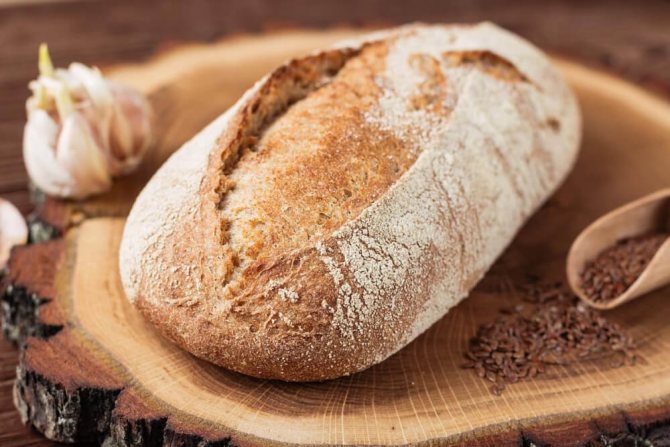
Despite the fact that bread is prepared without the use of yeast, it, like other varieties, can become stale. Typically, yeast-free bread can be stored for 7–10 days.
These terms are arbitrary and depend on the type and technology of baking. Storage conditions also affect the safety of the product. It is best to keep the loaf in plastic, paper, foil or cloth and put it in a bread bin or cupboard.
Gluten-free
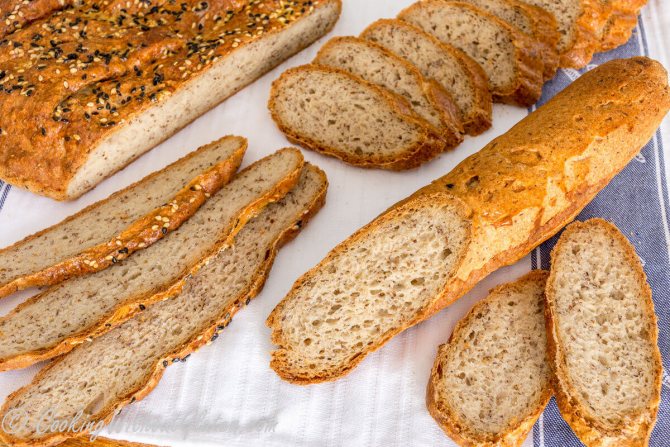
Gluten-free varieties differ from classic ones in that they contain types of flour that do not contain gluten. Such products are usually consumed by people who are intolerant to the substance or who want to eat more healthily.
The best place to store gluten-free bread is in the freezer. Once prepared or purchased, cut the loaf into pieces, portion and freeze. Before use, heat the required number of servings in the microwave.
Otrubnoy
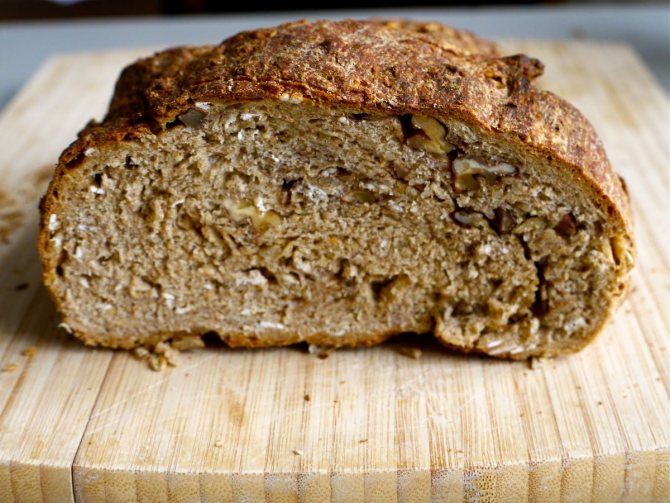
Products with bran differ from classic ones in that they contain bran in addition to flour. If you provide the bread with the proper conditions, keep it in cellophane, paper or a bread box, it will last 5-7 days without spoiling.
Bread crackers
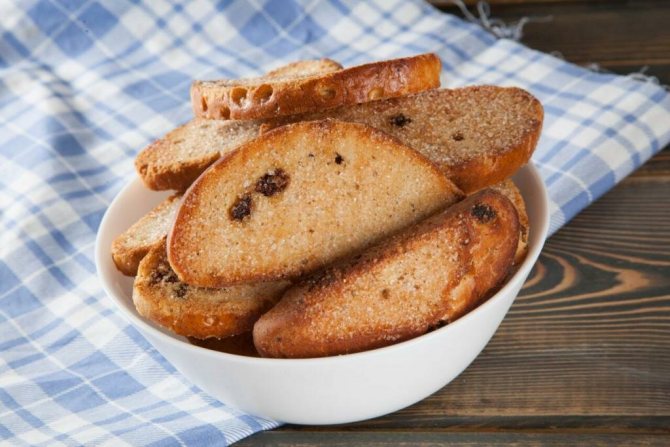
Such a product can remain in its proper form from several months to two years, but only if the required level of humidity is maintained in the room (no more than 75%).
Storage nuances:
- It is better to keep crackers in a dark and cool place;
- At the first sign of spoilage, immediately discard the product;
- do not place crackers near the bread, otherwise both products will become unusable faster;
- be sure to keep the crackers in the packaging: plastic or paper bag, fabric bag, foil;
- Rusks that are dried rather than fried (especially with the addition of oil) last longer;
- if the composition contains additional ingredients, the shelf life is reduced;
- Use snack crackers immediately after opening the package.
Secrets of proper bread care
In order for the loaf to remain soft for a long time, the place where it is stored should be kept clean and air circulated with a minimum of moisture. How to take care of your bread storage:
- daily clean the inside of the container from crumbs by wiping the surface with a dry towel, you can use a paper napkin;
- wash the bread box weekly with soap and water (if the material allows), then treat it with a 1% solution of acetic acid and let it dry thoroughly;
- It is advisable to cover the bottom of the container with clean paper or cloth; they are changed once a week - the paper is thrown away, the cloth is washed.
If you use paper bags, discard them after using the loaf. Canvas bags for storing baked goods must be washed once a week after consuming their contents. Foil and polyethylene are also used once, and plastic containers or an opened enamel pan are treated with dishwashing detergent, after which they are rinsed well and wiped dry.
Bread can be called a unique product that people have baked since time immemorial. Thanks to technological progress, methods for preserving bread products are being improved, but you should not buy more bread than you can use. After all, even long-term storage in the refrigerator does not save the loaf from spoilage.
Share Like Share Tweet Pin
Shelf life and storage of bakery products according to GOST
First of all, it is worth noting that the state standard for storing bread is established within the framework that is calculated for the sale of the product. This means that the actual shelf life of bakery products is slightly higher than the prescribed values. There are 2 types of GOST standards, which depend on the type of product, the method of its preparation and the presence of packaging.
- For products that can be stored for no more than 2 days. The packaging must contain not only the date, but also the time of packaging.
- For products that can be stored for more than 48 hours. The label will be marked with the date of packaging.
Storage standards for main types of bakery products:
- cut: in packaging – 72 hours, without packaging – 24 hours;
- white of the first category: in packaging 72 hours, without packaging – 24 hours;
- small loaves up to 200 g – no more than 16 hours;
- Borodinsky - 36 hours;
- crackers – 60 days.
Ways to turn frozen bread into fresh
There are several ways to revive a baked product after freezing.
- Simplest. Remove the bread from the freezer about four hours before eating and leave it wrapped until completely thawed at room temperature.
- In the oven. Place the product wrapped in parchment in the oven for five minutes, preheated to 200 °C.
- With a crispy crust. After thawing, place the bun in the oven for ten minutes, preheated to 180 °C, after greasing it with water.
- Using a steamer. Place the product in the device for 20 minutes. The period of time will largely depend on the size of the product being defrosted. Therefore, if, after piercing a piece with a knife, you are convinced that it is hard inside, you need to turn on the steamer for another 10–15 minutes.
- In a frying pan. Place the frozen slice in a frying pan over low heat without covering it with a lid.
Is it possible to freeze bread so that after defrosting it will look like fresh? After this procedure, the bread may be wet. However, it is enough to let it cool and dry, and it will regain its original qualities and taste.
How to preserve bread while traveling
If you are going on a hike or a picnic, take care of food. Typically, a tourist's food package also includes baked goods. To keep them fresh as long as possible:
- When choosing, give preference to varieties that have a maximum shelf life.
- Keep the products only in the packaging and do not allow moisture to get into it.
- Cut the loaf not from the edge, but from the middle. After cutting off the required amount, fold the halves and pack them in a bag. This way the bun will last longer.
A good idea would be to vacuum-pack the bread. Portion the product and pack it. Open one serving package before eating.
Bread will last longer if the necessary storage conditions are observed.
The main thing is not to let the product come into contact with air or sun rays. Of course, it is better to buy baked goods for future use, but if this is not possible, use simple tips and tricks to help extend the shelf life. Did you like the article? Was she helpful?
Shelf life
The time during which quality bread can be stored varies depending on the type of flour.
If the shelf life of the bread is coming to an end, then it is worth preparing crackers from it, cutting it into cubes or bars. They will come in handy later when you prepare homemade minced meat for cutlets or to bread a chop.
At the bakery, pay attention to the following facts:
- The baked goods should be whole, smooth and without dents.
- When applying pressure, quickly restore the original volume.
- Have a pleasant bready aroma.
- Be of a uniform color without dark spots or inclusions.
If at least one of the evaluation criteria does not meet the requirements, then it is better to refuse such a product.
The manufacturer is required to indicate on the packaging the shelf life of the baked product. If the manufacturer allows you to store your product for a long time, then this should alert you. It is highly likely that the composition contains many harmful chemicals that will have a bad effect on the body.
At home, you can extend the shelf life if you store it in vacuum packaging. This bread will be soft and fresh for a week to 10 days. It is convenient to take it with you on the road or on a hike.
Now let’s look at how long different types of bread can be stored.
| View | Shelf life at room conditions (in hours) | |
| Bread products weight | up to 200 grams | 16 |
| from 200 grams | 24 | |
| Made from wheat flour | unpacked | 24 |
| packed | 72 | |
| Borodinsky | 36 | |
| Wheat-rye | 96 | |
| From rye flour | 120 | |







